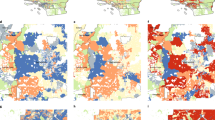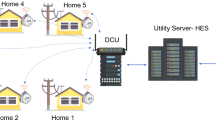Abstract
Innovative approaches are needed to address the needs of the 1.3 billion people lacking electricity, while simultaneously transitioning to a decarbonized energy system. With particular focus on the energy needs of the underserved, we present an analytic and conceptual framework that clarifies the heterogeneous continuum of centralized on-grid electricity, autonomous mini- or community grids, and distributed, individual energy services. A historical analysis shows that the present day is a unique moment in the history of electrification where decentralized energy networks are rapidly spreading, based on super-efficient end-use appliances and low-cost photovoltaics. We document how this evolution is supported by critical and widely available information technologies, particularly mobile phones and virtual financial services. These disruptive technology systems can rapidly increase access to basic electricity services and directly inform the emerging Sustainable Development Goals for quality of life, while simultaneously driving action towards low-carbon, Earth-sustaining, inclusive energy systems.
This is a preview of subscription content, access via your institution
Access options
Subscribe to this journal
Receive 12 print issues and online access
$209.00 per year
only $17.42 per issue
Buy this article
- Purchase on Springer Link
- Instant access to full article PDF
Prices may be subject to local taxes which are calculated during checkout






Similar content being viewed by others
References
IPCC Climate Change 2014: Impacts, Adaptation and Vulnerability (eds Field, C.B. et al.) (Cambridge Univ. Press, 2014).
SE4ALL Global Tracking Framework, 289 (UN Sustainable Energy For All, 2013).
Casillas, C. E. & Kammen, D. M. The energy–poverty–climate nexus. Science 330, 1181–1182 (2010).
IPCC Special Report on Renewable Energy Sources and Climate Change Mitigation (Cambridge Univ. Press, 2011).
Bazilian, M., Hobbs, B. F., Blyth, W., MacGill, I. & Howells, M. Interactions between energy security and climate change: A focus on developing countries. Energy Policy 39, 3750–3756 (2011).
Rong, F. Understanding developing country stances on post-2012 climate change negotiations: Comparative analysis of Brazil, China, India, Mexico, and South Africa. Energy Policy 38, 4582–4591 (2010).
Girod, B., Van Vuuren, D. P. & Hertwich, E. G. Global climate targets and future consumption level: an evaluation of the required GHG intensity. Environ. Res. Lett. 8, 014016 (2013).
Diffenbaugh, N. S. Human well-being, the global emissions debt, and climate change commitment. Sustain. Sci. 8, 135–141 (2013).
World Energy Outlook 2012 (OECD/IEA, 2012).
Hansen, J. et al. Assessing 'Dangerous Climate Change': Required reduction of carbon emissions to protect young people, future generations and nature. PloS ONE 8, e81648 (2013).
Mills, E. The specter of fuel-based lighting. Science 308, 1263–1264 (2005).
Bacon, R., Bhattacharya, S. & Kojima, M. Expenditure of Low-Income Households on Energy. Extractive Industries for Development Series 16 (World Bank, 2010).
Lam, N. L., Smith, K. R., Gauthier, A. & Bates, M. N. Kerosene: A review of household uses and their hazards in low-and middle-income countries. J. Toxicol. Environ. Health B 15, 396–432 (2012).
Mills, E. Health Impacts of Fuel Based Lighting (Lawrence Berkeley National Laboratory Lumina Project, 2012).
Lam, N. L. et al. Household light makes global heat: high black carbon emissions from kerosene wick lamps. Environ. Sci. Technol. 46, 13531–13538 (2012).
Cabraal, R. A., Barnes, D. F. & Agarwal, S. G. Productive uses of energy for rural development. Annu. Rev. Environ. Resour. 30, 117–144 (2005).
Modi, V., McDade, S., Lallement, D. & Saghir, J. Energy Services for the Millennium Development Goals: Achieving the Millennium Development Goals (International Bank for Reconstruction and Development/World Bank/UNDP, 2005).
Maximizing Mobile: Information and Communication Technologies for Development (World Bank, 2012).
Burrell, J. & Matovu, J. Livelihoods and the Mobile Phone in Rural Uganda (Grameen Foundation, 2008).
Goldemberg, J., Johansson, T. B., Reddy, A. K. & Williams, R. H. Basic needs and much more with one kilowatt per capita. Ambio 14, 190–200 (1985).
Pasternak, A. D. Global Energy Futures and Human Development: A Framework for Analysis. US Department of Energy Report UCRL-ID-140773 (Lawrence Livermore National Laboratory, 2000).
Ghosh, S. Electricity consumption and economic growth in India. Energy Policy 30, 125–129 (2002).
Jumbe, C. B. Cointegration and causality between electricity consumption and GDP: Empirical evidence from Malawi. Energy Econ. 26, 61–68 (2004).
Wolde-Rufael, Y. Energy consumption and economic growth: The experience of African countries revisited. Energy Econ. 31, 217–224 (2009).
Wolde-Rufael, Y. Electricity consumption and economic growth: A time series experience for 17 African countries. Energy Policy 34, 1106–1114 (2006).
Chen, S-T., Kuo, H-I. & Chen, C-C. The relationship between GDP and electricity consumption in 10 Asian countries. Energy Policy 35, 2611–2621 (2007).
Cecelski, E. Energy, Development, and Gender: Global Correlations or Causality. (ENERGIA, 2005).
Nussbaumer, P., Bazilian, M. & Modi, V. Measuring energy poverty: Focusing on what matters. Renew. Sustain. Energy Revi. 16, 231–243 (2012).
Sovacool, B. K. The political economy of energy poverty: A review of key challenges. Energy Sustain. Devel. 16, 272–282 (2012).
Hughes, T. P. Networks of Power: Electrification in Western Society, 1880–1930 (Johns Hopkins Univ. Press, 1983).
Hausman, W. J., Hertner, P. & Wilkins, M. Global Electrification: Multinational Enterprise and International Finance in the History of Light and Power, 1878–2007 (Cambridge Univ. Press, 2011).
Rosnes, O., Shkaratan, M. & Vennemo, H. Africa's Power Infrastructure: Investment, Integration, Efficiency (World Bank, 2011).
Johansson, T. B., Patwardhan, A., Nakicenovic, N. & Gomez-Echeverri, L. Global Energy Assessment: Toward a Sustainable Future (Cambridge Univ. Press/International Institute for Applied Systems Analysis, 2012).
Tully, S. The human right to access electricity. Electric. J. 19, 30–39 (2006).
Bhattacharyya, S. Rural Electrification through Decentralised Off-grid Systems in Developing Countries (Springer, 2013).
Goldemberg, J., Rovere, E. L. L. & Coelho, S. T. Expanding access to electricity in Brazil. Energy Sustain. Devel. 8, 86–94 (2004).
Lee, K. et al. Barriers to Electrification for 'Under Grid' Households in Rural Kenya. (Center for Effective Global Action, 2014).
Foley, G. & Logarta, J. in The Challenge of Rural Electrification: Strategies for Developing Countries 45–73 (2007).
Azevedo, I. L., Morgan, M. G. & Morgan, F. The transition to solid-state lighting. Proc. IEEE 97, 481–510 (2009).
Park, W. Y., Phadke, A., Shah, N. & Letschert, V. TV Energy Consumption Trends and Energy-Efficiency Improvement Options. Report no. LBNL-5024E (Lawrence Berkeley National Laboratory, 2011).
Gopal, A., Leventis, G., Phadke, A. & de la Rue du Can, S. in ECEEE Summer Study http://go.nature.com/2fZjSj (2013).
Shah, N., Sathaye, N., Phadke, A. & Letschert, V. Efficiency improvement opportunities for ceiling fans. Energy Effic. 8, 37–50 (2013).
Koomey, J. G., Berard, S., Sanchez, M. & Wong, H. Implications of historical trends in the electrical efficiency of computing. IEEE Ann. History Comput. 33, 46–54 (2011).
Tsao, J. Y. Solid-state lighting: lamps, chips, and materials for tomorrow. IEEE Circ. Devices Mag. 20, 28–37 (2004).
Feldman, D. et al. Photovoltaic System Pricing Trends: Historical, Recent, and Near-Term Projections (NREL/LBNL, 2014); http://go.nature.com/Mzf8Kg
Green Power for Mobile: Charging Choices / Off-grid Power for Mobile. (GSM Association, 2011).
Ezzati, M. & Kammen, D. M. Indoor air pollution from biomass combustion and acute respiratory infections in Kenya: An exposure–response study. Lancet 358, 619–624 (2001).
Alstone, P., Lai, P., Mills, E. & Jacobson, A. High life-cycle efficacy explains fast energy payback for improved off-grid lighting systems. J. Indust. Ecol. 18, 722–733 (2014).
From Gap to Opportunity: Business Models for Scaling Up Energy Access. (International Finance Corporation (IFC), 2012).
Stewart Craine, E. M. & Guay, J. Clean Energy Services for All: Financing Universal Electrification (Sierra Club, 2014).
Bazilian, M. et al. Understanding the scale of investment for universal energy access. Geopolit. Energy 32, 19–40 (2010).
Mills, E. The $230 billion global lighting energy bill (Lawrence Berkeley National Laboratory, 2002).
Mills, E., Tracy, J. L., Alstone, P., Jacobson, A. & Avato, P. Low-cost LED flashlights and market spoiling in Kenya's off-grid lighting market. Energy Effic. 1–15 (2014).
Quetchenbach, T. et al. The GridShare solution: a smart grid approach to improve service provision on a renewable energy mini-grid in Bhutan. Environ. Res. Lett. 8, 014018 (2013).
Akerlof, G. A. The market for 'lemons': Quality uncertainty and the market mechanism. Q. J. Econ. 84, 488–500 (1970).
Painuly, J. P. Barriers to renewable energy penetration; a framework for analysis. Renew. Energy 24, 73–89 (2001).
Nique, M. & Arab, F. Sustainable Energy and Water Access through M2M Connectivity. (GSM Association, 2013).
Soto, D. et al. in Proc. Fifth Int. Conf. Information and Communication Technologies and Development 130–138 (ACM, 2012).
Alstone, P., Niethammer, C., Mendonça, B. & Eftimie, A. Expanding Women's Role in Africa's Modern Off-Grid Lighting Market (Lighting Africa Project, IFC, 2011).
Donner, J. & Tellez, C. A. Mobile banking and economic development: Linking adoption, impact, and use. Asian J. Commun. 18, 318–332 (2008).
Ilavarasan, V. & Levy, M. R. ICTs and Urban Microenterprises: Identifying and Maximizing Opportunities for Economic Development (IDRC, 2010).
Dalberg Global Development Advisors. Lighting Africa Market Trends Report 2012. (DGBA, 2012); http://www.lightingafrica.org/resources/market-research/market-trends/
Rosa, J., Madduri, P. A. & Soto, D. in IEEE Global Humanitarian Technology Conference http://doi.org/2qj (2012).
Kenya Integrated Household Budget Survey (Kenya National Bureau of Statistics, 2005).
Borenstein, S. A Microeconomic Framework for Evaluating Energy Efficiency Rebound and Some Implications (National Bureau of Economic Research, 2013).
Jacobson, A., Milman, A. D. & Kammen, D. M. Letting the (energy) Gini out of the bottle: Lorenz curves of cumulative electricity consumption and Gini coefficients as metrics of energy distribution and equity. Energy Policy 33, 1825–1832 (2005).
Clark, M. L. et al. Impact of improved cookstoves on indoor air pollution and adverse health effects among Honduran women. Int. J. Environ. Health Res. 19, 357–368 (2009).
Acknowledgements
P.A. was supported by the EPA STAR graduate fellowship, D.G. by the NSF Graduate Research Fellowship Program, and all were supported by NSF grant SMA-1338539, Information–Energy Nexus Research Network. We acknowledge the valuable contributions of data from the Lighting Africa programme (where P.A. is also a contributor), the Kenya National Bureau of Statistics, and multiple institutions and organizations that publicly share the critical data on energy systems that we assembled in this work. We are grateful for discussions on super-efficient appliances with A. Jacobson, A. Phadke and others at Humboldt State and LBNL. Thanks to N. Bryant, M. Mumbi, and D. Mugo for collaborating on fieldwork that informs our discussion of ICT and energy. This work benefited greatly from feedback provided by participants in seminars at UC Berkeley and from the comments of three anonymous reviewers.
Author information
Authors and Affiliations
Contributions
P.A., D.G. and D.M.K. conceived the work. P.A. designed and implemented the analysis and was lead author. D.G. and D.M.K. contributed to the analysis and writing.
Corresponding author
Ethics declarations
Competing interests
The authors declare no competing financial interests.
Supplementary information
Supplementary Information
Decentralized energy systems for clean electricity access (PDF 1128 kb)
Rights and permissions
About this article
Cite this article
Alstone, P., Gershenson, D. & Kammen, D. Decentralized energy systems for clean electricity access. Nature Clim Change 5, 305–314 (2015). https://doi.org/10.1038/nclimate2512
Received:
Accepted:
Published:
Issue Date:
DOI: https://doi.org/10.1038/nclimate2512
This article is cited by
-
Exploring the potential role of decentralised biogas plants in meeting energy needs in sub-Saharan African countries: a techno-economic systems analysis
Sustainable Energy Research (2024)
-
Shaping a resilient future in response to COVID-19
Nature Sustainability (2023)
-
A bibliometric analysis of sustainable development goals (SDGs): a review of progress, challenges, and opportunities
Environment, Development and Sustainability (2023)
-
Challenges in platforming and digitizing decentralized energy services
Energy Informatics (2022)
-
Accounting for finance in electrification models for sub-Saharan Africa
Nature Energy (2022)



